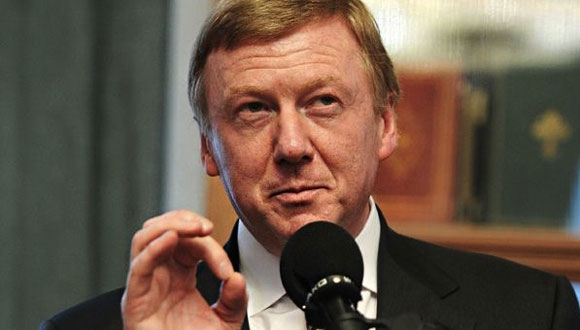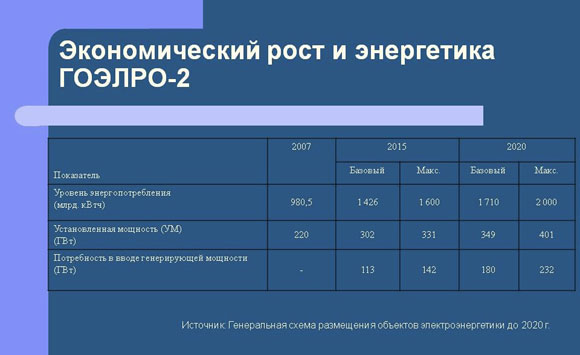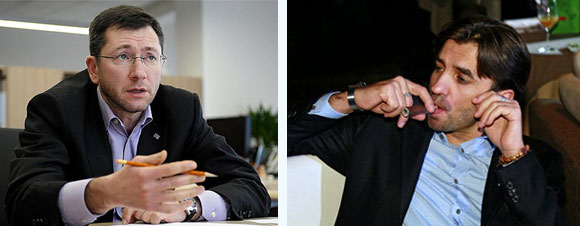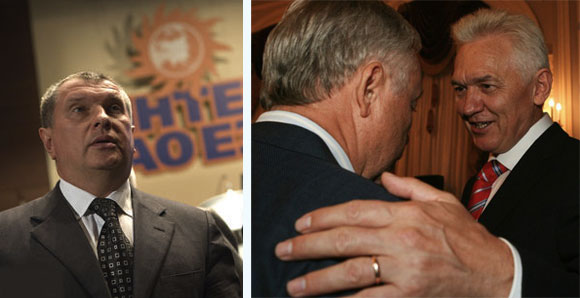During the recent Asian Pacific Ocean Economic (APEC) summit, Russia marketed natural gas pipelines to Asia and the railway route from Asia to Europe. However, one may reasonably doubt the ability of Russian monopolies to execute such ambitious projects. Recent news about Russian Railways reveals a deep crisis within the company, while Gazprom’s high current profits mask the collapse of its long-term strategy. According to IMR economic advisor, Igor Booth, these two Russian giants, in order to reach their full potential, need to adopt best change management practices and, in particular, study the Russian electric power sector’s experience of reform.

Although reform of Russia’s monopolies has been discussed for years, the government does not have a clear plan for its implementation. In the government’s discussion of change, much attention is given to developing economic models and the desired results, but the management of reform remains ignored. Achieving change is left to “strong leaders,” which, in effect, is to act in accordance with Stalin’s famous saying “Human resources are the key to everything.” Even if the Soviet totalitarian management system ceased to exist decades ago, Russian leaders still act as if those methods were still in place.
Nevertheless, Russia can offer an example of successfully breaking up a monopoly: the liquidation of RAO UES, the electrical power utility. Electric power sector reform was the most ambitious structural reform in Russia, with publicly announced goals and results that could be measured. The use of best change management instruments helped to achieve many of the reform’s objectives. At the same time, crucial managerial oversights prevented creation of a fully competitive electric power sector. To analyze this reform we will use the classical model of change management, as described by John P. Kotter, Professor of Leadership at the Harvard Business School.
The Last Reform of the Revolutionary 90’s
At the end of the 90’s, before the reform started, RAO UES was engaged in all kinds of activities, both related and unrelated to its core business. At the same time, the company did not have effective controlover many of its assets. Regional governors and, standing behind them, large industrial electric power consumers made key decisions about the company’s business. Corruption was widespread at all levels of management. Even standard operations, such as purchasing fuel, maintenance, collecting debts from customers and getting credit, demanded extraordinary efforts of the company’s top-management. A number of regional electric power systems were on the edge of technical collapse or engaged in drawn-out corporate wars over ownership of their key assets.
At this time, RAO UES was the only real blue chip company on the Russian stock exchange. With 48% of shares owned by private investors, the company contributed more than half the trading volume on the Russian stock market.

In the 1990’s RAO UES formally owned numerous assets throughout the country, but it did not have real control over them.
In 1998, Anatoly Chubais, one of the key economic reformers in the Boris Yeltsin administration, became the RAO UES CEO. He spearheaded the electric power sector reform, which can be divided into four parts:
• Creating a for profit enterprise on the basis of Soviet era assets;
• Splitting the company into several entities based on their different activities;
• Privatization of the sector; and
• Liberalization of the electricity market, developing a set of rules to trade electric power.
In 1998, the economic reforms in Russia had stalled: there was neither political backing for reforms from the top nor demand for them from the people. In such an inhospitable environment, the electric power sector reform became one of the largest and sophisticated transformations in the history of management. It is also one of the most successful large-scale corporate change projects in Russia: the first two goals of creating a sustainable business and splitting different activities into separate entities were fully accomplished. Technically, the sector was privatized, although the government and state-owned companies, today, still remain the major owners of the electric power assets in Russia. The liberalization of the electric power market-a key stage of the reform-is incomplete and stalled. Managerial mistakes have resulted in delay and failure to fully realize the remaining goals.
Seven Victories on the Road to Change
Building an organization
It is often said that crisis is not the best impetus for change. As Alan Deutschman convincingly demonstrates in his book Change or Die, even the threat of death is not enough to make people change their habits. During a crisis, any system is occupied with preserving-not improving-itself. There is no reason to replace an engine on a sinking ship before the holes are plugged.
In RAO UES, anti-crisis management preceded the reforms. It took several years to regain full operational control over the company’s assets, normalize payment collection from customers, curb corruption at the lower levels of the organization and establish transparent corporate procedures. Only after RAO UES stabilized its operations and financial position was it ready for reform.
Radical changes
When moving towards reform, any bureaucracy prefers making small steps and gradual “evolutionary” changes. However, people and organizations cannot function effectively during long periods of change. According to Bain & Company research, successful corporate reforms are typically finished in two years. Fast, radical and transparent changes are usually the only way to achieve successful corporate reforms.
From the very beginning, RAO UES was on track for radical change. Considering the sector’s complexity, the changes needed more than two years. The initial “3+3” plan was replaced by a “5+5” plan meaning five years for the company’s stabilization and developmentof a reform plan, and five years for reform implementation.
Sweeping changes took place soon after Anatoly Chubais took charge of the electric power sector. In just several months most of the regional division’s managers were dismissed and top management completely replaced. It was the old guard, mainly people with engineering backgrounds, who had sabotaged all previous attempts to transform the company. The team overhaul was done quickly, publicly and in a transparent manner. Chubais announced new work rules and new requirements for managers. Those, who were not able to comply withthe new order were fired ortransferred from executive to operational positions.

Anatoly Chubais, one of ideologists and key economic reformers of the 1990s, was also behind the reform of the Russian electric power sector during the early part of this century.
New opportunities were thus created for young and ambitious managers. Some of thosewho joined RAO UES as interns in the beginning of the reform progressed to key positions in electric power companies or in the bodies regulating the industry.
A complete change in upper management is essential for effective change in a complex system. In the classical American case of Lee Iacocca’s restructuring of Chrysler at the end of 1970s, only two out of 50 top-managers joined the new team. At the beginning of this century, new CEOs were appointed to most state-owned monopolies.In contrast to the changes made at RAO UES, these more recent changes have been gradual, opaque, and basedon personal connections and loyalty, not merit.
Shaping a vision
It is difficult to implement major organizational changes when a company’s various stakeholders do not share a common view of its prospects. In the case of RAO UES, the convergence of the views of the conservative “engineers” who traditionally ran the electric power sector since the Soviet times and the liberal-minded “managers” who came to change the industry was very much needed. A distinguishing feature of the reform plan’s development was that it was openly discussed with the participation of all interested parties, including its opponents. This way of developing thereform plan was a powerful instrument to create a unifying vision of the industry’s future.
The public debates on the reform created discomfort for RAO UES’ top-managersand delayed the reform process by several years. However, the open and inclusive discussion process helped to minimize the risk of mistakes during the implementation and prevented resistance from the important stakeholders at the reform’slater stages. The top management of RAO UES demonstrated itsability to listen, make changes to the initial plans and openly acknowledge its own mistakes.
Establishing a sense of urgency and inevitability of change
The CEO’s of state owned enterprises usually prefer to report only good news and downplay problems. As a result, difficulties become known only when they are impossible to hide. For example, the recent inability of Russian Railways to transport goodsas well as Gazprom’s abrupt drop of exports in 2008-2009 came as a surprise both to the government and to the investing public. Nobody publicly discussed the possibility of such dramatic events before they actually happened. As a result, the reforms of therailway and natural gas sectorshave not been regarded as urgent or necessary and are constantly delayed and postponed.

In order to win support for the reform from the average consumer, RAO UES employed Soviet style rhetoric and announced the GOELRO-2 plan, which echoed one of Lenin’s biggest campaigns.
Unlike his peers from other state-owned companies, Anatoly Chubais, in the beginning of the 2000’s warned about a probable collapse in the electric power sector by 2008. He used the popular idea that Soviet industrial assets had physically deteriorated by 50-80% because of the investment freeze in the 90’s. All major media published articles on “Chubais' cross,” a graph, demonstrating that, absent change the growing demand for electricity would soon exceed the declining supply because of deteriorating power capacity. The two lines intersected in 2006, demonstrating Chubais’ thesis of an imminent collapse in the electric power sector.
The Moscow blackout in 2004 could have cost Chubais his career in the electric power sector. Instead, the reformer turned it to his advantage to speed up reform. Colorful graphs of electric demand versus electrical supply, supported by the experience of a major power outage by millions Muscovites, helped to frighten the government enough to get the green light for reform.
The threat, even if exaggerated, was needed to force stakeholders to take decisions which otherwise could have been postponed for years. Although the new electric power capacity was not built in the amount needed according to the "Chubais' cross," no major blackouts occurred after 2004. When the reform was completed, a cool-headed analysis demonstrated that there was no urgent need for new electric power stations. Soviet-era power plants, though obsolete, inefficient and often polluting, remain the most profitable and reliable option to meet the country’s energy requirements through the year 2020. The worst power supply problems were in the growing metropolitan areas and oil-producing regions and these were remedied by 2008.Many other investment projects were postponed or cancelled when the economy cooled down during the economic crisis of 2008-2009.

The so-called Chubais' cross, a graph, demonstrating that, absent change the growing demand for electricity would soon exceed the declining supply because of deteriorating power capacity.
The sense of urgency and inevitability for change wasreinforcedby the public statements of RAO UES management. Unlike other state-run companies, RAO UES did not hesitate toannounce openly its plans and deadlines, thereby binding the government to the same commitments. For example, the company announced in advance the date of its final liquidation as well as the schedule for selling its subsidiaries. Almost a year before the liquidation, the company sold its main office building. Everyone realized there was no going back, that the company’s assets would be sold and it would cease to exist. Still, the company avoided the loss of employee morale that is usually found in an organization about to be liquidated.
Communicatingavision of change
The electric power sector is a very politically sensitive part of the economy. To be effective, a persuasive vision of change needed to be communicated not only to employees, investors and consumers, but also to all country’s citizens, politicians and the President of Russia. Few if any of them would have supported changes described as privatization, liberalization and the company’s breakup. Thus, a different way of expressing the changes was needed in order to win over the various stakeholders.
Though he personified the liberal market reforms of the 90s, Chubais employed the rhetoric of his ideological opponents to promote the privatization of RAE UES. Soviet era propaganda is something that all grown-ups in Russia are familiar with. One of the Soviet Union’sself-proclaimed successes was Lenin’s project to extend electrification throughout the country under the State Commission for Electrification of Russia (GOELRO). According to Soviet mythology, the GOELRO plan enabled the great spurt of Soviet industrialization and was often cited as proof of the advantages of a central-planning system over a market-based capitalist system.
In line with this, RAO UES announced “GOELRO-2,” echoing the Soviet-era campaigns for utopian projects (which could not be completed even inthe best of times). In fact, GOELRO-2 included completing projects originally planned but not realized under the so-called "GOELRO-1." Unlike "GOELRO-1", new electric power stations were to become a reality through private investments and a well-functioning market system, thus demonstrating the ability of the new Russian economy to execute ambitious investment projects.

According to GOELRO-2, in 2007-2020 a new energy system would be built, doubling the existing capacity.
To capture the attention of market oriented people, Chubais released an ambitious plan to attract 100 billion dollars to the Russian electric power system. Investors were promised multiple returns on their investment while industrial consumers were promised fair prices. Thus a new imaginary world with its special vocabulary and myths was created, and the reform participants were invited to live in it.
Short-term achievementshelpedto create a positive image of the reforms. The construction of the gigantic Boguchanskaya hydroelectric power plant in Siberia was restarted in 2006, almost 15 years after construction was frozen. In 2007 the construction of another important hydroelectric power plant was finished in Far East. Other successes in the early 2000s included the company’s increased profitability, improved capitalization, and strengthened financial condition. Even though these attainments were not directly connected with the reforms, they were vital in demonstrating the management’s ability to get things done.
In contrast with RAO UES, Gazprom and Russian Railways have not yet communicated their visions of change. Nobody knows exactly how these sectors will be reformed or if there will be any reform at all. For example, the government’s ministers announced plans to privatize Russian Railways, and the latter’s president, Vladimir Yakunin, asked that it be delayed. Yakunin, an old friend of Vladimir Putin, believes that the only thing that the railway sector needs is more subsidies from the government. The same uncertainty surrounds Gazprom, which, depending on the situation, at first welcomes and then obstructs plans to create a market for natural gas. For an outside observer, changes in the Russian Railways and Gazprom look chaotic and inconsistent.
Forming pro-reform coalitions
Powerful supportive coalitions are essential for advancing change at any organization. The scale and duration of the electric power sector transformation required building different coalitions at different stages of reform. At the first stage, Mikhail Abyzov, a talented executive from the fuel and energy sector, was able to act decisively in the aggressive environment of the 90’s. His entrepreneurial skills werea crucial factor in returning to the company control over its assets and the ability to collect debts owed by its industrial consumers. At the final stages, the intellectual Boris Vainsikher, technical director of RAO-UES with a strong engineering background, was instrumental in formingthe sector’s long-term development plans. At the same time, the core of the reforming team consisted of people who had worked with Chubais in the Yeltsin government before the electric power sector reform.

Boris Vainzinkher (left), former technical director of RAO UES; Expert magazine named him one of the most versatile top-managers in Russia. Mikhail Abyzov (right), a successful Russian businessman, currently with the rank of Minister, responsible for coordinating the government’s relations with the so-called "Open [Transparent] Government" program.
In addition to the RAO UES executives, the guiding coalition included many stakeholders from outside the company. The active support of ministers, governors of key regions, financial investors, influential oligarchs and industrial consumers was crucial to the reform’s success. After becoming the company’s CEO, Chubais secured his position by making changes to the company’s charter so that the government, even though it was the majority shareholder, could not fire him without the support of a majority of the remaining shareholders. This made him immune from the attacks by the communists, who in the 90’s controlled the Duma (the lower chamber of the Russian parliament). Later, when the reform agenda changed and dependency on financial investors became a burden, Chubais amended the charter again, such that his position now rested on support from reform-minded ministers in Putin’s government. A scientific approach to planning reforms and the desire to implement international best practices helped draw thesupport of the expert community. Unlocking new opportunities for private investors attracted powerful Russian oligarchs and politically influential European companies to the coalition.
Removing obstacles to change
Any coalition, at some point, faces roadblocks impeding change. Corruption and vested interests are often the reason for reform failures. Because the electric power sector is a heavily regulated industry, a slowly moving bureaucracy and political populism provide two additional obstacles to reform.
The idea of free markets was not enough to keep the broad reform coalition together. All reform supporters, including managers, Russian oligarchs, international investors and consultants profited from the reform. However, their selfish profit-maximizing interests instead of drowning the reform became an engine for change. If the reform’s leaders hadconcentrated on fighting corruption, it would havestopped the whole process and made any coalition impossible. The change’s success rested on offering benefits to all of the reform’s stakeholders.
In other Russian state-owned companies, corruption and vested interests often block any progress. The government often resorts to brutal force against such interests, but this usually results in long-lasting conflicts, damages the reputation of the both sides, and ends up as asimple redistribution of assets. The ability to work with the shadowy interests within a state company is among the key skills necessary to be a successful reformer in Russia.
Two Defeats
The electric power sector reform in Russia successfully overcame many of the typical obstacles to change described by John Kotter in his article “Leading Change: Why Transformation Efforts Fail.” However, at the very end of the change process, RAO UES made serious mistakes that in many ways undermined the reformers’ earlier successes.
First,when victory was declared after ten years of reform effort, it was premature. At that time, the liberalization of the electric power market was not completed and too many assets remained under the effective control of the government. The end of the reform effort was celebrated both by its opponents and initiators. For the reformers it was a Pyrrhic victory: after ten years the Chubais team and its adherents completely lost their political independence. While in the beginning the Chubais’ teamwas able to make flexible alliances with different stakeholders, at the end it fully depended on Putin whofavoredexpanding Gazprom’s role in the electric power sector over enhancing competition among energy companies.
Second, changes in the electric power sector did not take root in overall economic policy. After the Chubais team was swept out of the electric power sector, the reform’s opponents swiftly took their revenge for the years of liberalization and privatization. State-owned RusHydro and InterRAO expanded their assets base far beyond their initial core activities: hydroelectric power generation and import and export of Electric power, respectively. Although the liberal-minded Federal Anti-monopoly Service managed to block the worst scenarios of a new monopolization, the reformed electric power sector found itself squeezed between Gazprom and powerful industrial consumers, such as Rusal, the world’s largest aluminum company. As a result, Gazprom and several large energy consumers divided among themselves the most attractive assets of RAO-UES, leaving much less competition in the electricity market than originally planned. The resulting high level of monopolization justified delayin liberalizing the market for electric power.
The RAO UES case can be used as a model for reforming other “natural” monopolies in Russia. However, the reform of Gazprom, the Russiangas monopoly, is not among the Russian government’s top priorities. For the second year in a row, the natural gas behemoth is the world’s most profitablepublicly traded company.The respected Harvard Business Review named Alexei Miller, Gazprom’s CEO, (but not Anatoly Chubais) the best CEO in the emerging markets.

Russian President's confidants: Igor Sechin (left), president of Rosneft, profiled by IMR in the article “The Kremlin's Gray Eminence,” and the Finnish businessman Gennady Timchenko (right), in 2011 ranked by the Russian Forbes as 26th on its list of the 200 richest people in Russia. In early 2012, according to RBC Magazine, Timchenko's wealth was estimated to be over $22 billion.
The gas monopoly’s financial success and international recognition do not contribute to creating a sense of urgency for change. However, the shale gas revolution and liquefied gas development, both of which were underestimated by Gazprom, might trigger a chaotic decline of the monopolist. An unusual coalition for change could be formed by the company’s outside stakeholders, including influential friends of Putin who have been making bets in the natural gas sector, liberal-minded ministers from the Medvedev’s government and Russian oil tycoons.